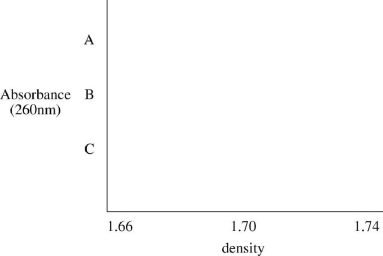Short Answer
Assume that you grew a culture of E.coli for many generations in medium containing ¹⁵N (from the ammonium ion),a heavy isotope of nitrogen.You extract DNA from a portion of the culture and determine its density to be 1.723 gm/cm³ (call this sampleA).You then wash the remaining E.coli cells and grow them for one generation in ¹⁴N,extract the DNA from a portion of the culture,and determine its density to be 1.715 gm/cm³ (call this sampleB).You let the culture grow for one more generation in ¹⁴N,and extract the DNA (call this sampleC)is then heated to completely denature the double-stranded structures,cooled quickly (to keep the strands separate),and subjected to ultracentrifugation.Present the centrifugation profiles for heat-denatured DNA (samples A,B,andC)that you would expect.Use the graph below.(Note: Although not the case,assume that single-stranded DNA has the same density as double-stranded DNA.).Each sample of DNA (A,B,andC)

Correct Answer:

Verified
Correct Answer:
Verified
Q24: Briefly describe what is meant by the
Q39: DNA replication occurs in the 5′ to
Q40: Which terms accurately reflect the nature of
Q41: What term is used to describe genetic
Q42: The complex of proteins that is involved
Q43: Chromatin assembly factors (CAFs)move along with the
Q45: Assume that a culture of E.coli was
Q46: Which structural circumstance in DNA sets up
Q47: Bacteria are dependent on telomerase to complete
Q49: What three possible models were suggested to